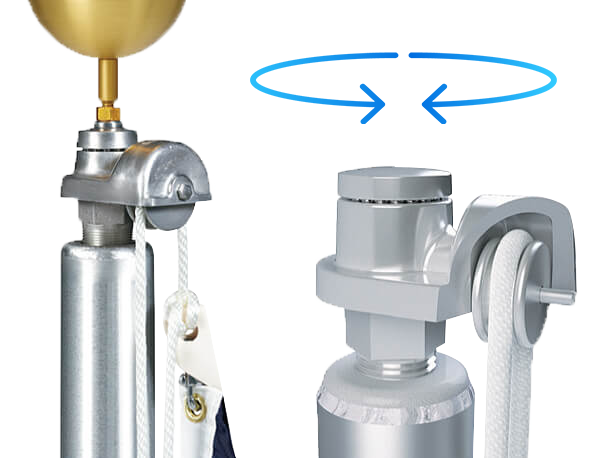Concord American External Halyard Flagpoles
External Halyard Flagpoles feature the rope halyard positioned on the exterior of the flagpole shaft. They use a flagpole truck that includes an exposed pulley, rope halyard, and cleat. These flagpoles are suitable for use in both commercial and residential settings.
No products found
External Halyard Systems

Description: External Halyard Flagpoles have the rope halyard visible on the outside of the flagpole shaft.
Components: These flagpoles use an external truck assembly with a visible pulley, a rope halyard, and an external cleat. The cleat is typically mounted about 4-1/2 feet above grade and allows for easy adjustment of the flag's position.
Cost: External Halyard Flagpoles are generally more affordable compared to Internal Halyard Flagpoles, making them a cost-effective option.
Height Range: They are available in a variety of heights, typically ranging from 20 ft to 80 ft.
Advantages: They are simpler to operate and maintain due to the external components being easily accessible.
Disadvantages: The rope and cleat are exposed to the elements, which may require more frequent maintenance and can be less secure. Additionally, the external rope may be more susceptible to wear and vandalism.
External Trucks
An External Truck is mounted at the top of an External Halyard Flagpole and provides the pulley system necessary for raising and lowering the flag using a rope halyard. The choice of truck can affect both the functionality and aesthetic of the flagpole.
Types of External Trucks:

Single Revolving (Spindle Design)
- Description: A revolving truck rotates with the wind, allowing the flag to spin freely.
- Features: Includes a pulley system that turns with the wind, reducing flag wear and providing a more dynamic display.
- Advantages: Reduces flag tangling and wear caused by wind friction; offers a more polished look with a flag that can turn to face the wind.
- Disadvantages: Slightly more expensive due to the additional moving parts; requires periodic maintenance to ensure smooth operation.

Double Revolving (Spindle Design)
- Description: A double revolving truck features two pulleys and is designed for multiple halyards or larger flags.
- Features: Includes an extra cleat and a double halyard assembly, allowing for the display of multiple flags or larger flags.
- Advantages: Ideal for more complex flag displays where multiple flags need to be flown simultaneously; offers flexibility and enhanced functionality.
- Disadvantages: Higher cost and more complex installation compared to single pulley systems; may require additional maintenance.

Stationary Truck (Cap Design)
- Description: A stationary truck is fixed in place and does not rotate.
- Features: It is a cost-effective option that includes a single pulley for the halyard.
- Advantages: Simplicity and durability; less maintenance required as there are no moving parts to wear out.
- Disadvantages: Flags may experience more friction and wear as they do not rotate with the wind, which can lead to uneven wear or snagging.
Summary:
The choice between a stationary truck, a revolving truck, or a double revolving truck will depend on factors such as the number of flags to be flown, the wind conditions in your area, and your budget. Each type has its advantages and potential drawbacks, so selecting the right truck will help ensure the optimal performance and longevity of your flagpole system.